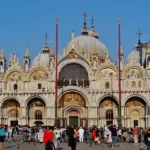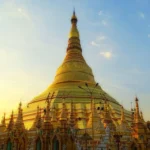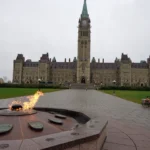
The Potala Palace, a magnificent architectural marvel nestled in the heart of Lhasa, Tibet, stands as a symbol of spiritual devotion, cultural richness, and historical significance. With its towering presence, intricate design, and profound heritage, the palace beckons visitors to embark on a journey through centuries of Tibetan history and tradition. Let’s delve deeper into the fascinating world of the Potala Palace and uncover the secrets and splendor that define this iconic landmark.
The Potala Palace, situated at a lofty elevation of 3,700 meters (12,100 feet) above sea level in Lhasa, Tibet, commands a breathtaking view of the surrounding landscape. This high-altitude location adds to the palace’s mystique and grandeur, making it a truly awe-inspiring architectural marvel.
Originally commissioned by King Songtsen Gampo in the 7th century, the Potala Palace underwent significant expansions and renovations over the centuries. The current structure we see today, primarily constructed in the 17th century, reflects a blend of historical influences and architectural styles that have shaped its iconic appearance.
Boasting an impressive layout with over 1,000 rooms, 10,000 shrines, and approximately 200,000 statues, the Potala Palace stands as a testament to the intricate craftsmanship and artistic mastery of its builders. Each room and shrine within the palace holds a piece of Tibetan history and culture, creating a rich tapestry of spiritual significance.
Recognized as a UNESCO World Heritage Site in 1994, the Potala Palace’s inscription underscores its universal value as a cultural treasure. This prestigious designation acknowledges the palace’s profound historical importance and its enduring legacy as a symbol of Tibetan heritage.
As the highest ancient palace in the world, towering at 13 stories tall, the Potala Palace commands attention with its imposing stature and architectural grandeur. Its towering presence against the backdrop of the Tibetan landscape evokes a sense of reverence and wonder among visitors and admirers alike.
Comprising the White Palace and the Red Palace, the Potala Palace complex embodies a harmonious fusion of architectural elements that reflect the rich cultural diversity of Tibet. The distinct features of each palace section offer a glimpse into the historical, religious, and administrative functions that once defined this majestic structure.
Serving as the winter residence of the Dalai Lamas from the 7th century until the 14th Dalai Lama’s exile in 1959, the Potala Palace holds a significant place in Tibetan history. The palace’s association with the Dalai Lamas underscores its spiritual and political importance as a center of Tibetan governance and religious authority.
Adorned with an impressive array of around 200,000 Buddha statues, the Potala Palace is a treasure trove of religious artistry and cultural heritage. Each statue within the palace walls reflects a unique expression of devotion and artistic skill, contributing to the palace’s spiritual ambiance and aesthetic allure.
Named after Mount Potalaka, the mythical abode of the bodhisattva Avalokitesvara, the Potala Palace carries a deep spiritual significance in Tibetan Buddhism. This sacred connection to a revered spiritual figure imbues the palace with a sense of divine presence and reverence, making it a pilgrimage site for devout followers and curious visitors alike.
With walls that are 3 meters (10 feet) thick at the base and 5 meters (16 feet) thick at the top, the Potala Palace stands as a formidable fortress of cultural heritage and architectural ingenuity. The palace’s robust construction not only speaks to its historical significance but also serves as a testament to the craftsmanship and engineering prowess of its builders.
The Potala Palace houses numerous precious artifacts, including intricate murals, thangkas (Tibetan Buddhist paintings), and sculptures that showcase the rich artistic heritage of Tibet. Each artwork within the palace walls tells a story of spiritual devotion, cultural tradition, and historical significance, offering visitors a glimpse into the vibrant tapestry of Tibetan artistry.
Within the Great West Hall of the Red Palace lie the tomb stupas of several Dalai Lamas, serving as sacred monuments to honor their legacies and spiritual contributions. These elaborately adorned stupas stand as symbols of reverence and remembrance, embodying the deep spiritual connection between the Dalai Lamas and the Potala Palace.
Renovated extensively in the 17th century under the rule of the fifth Dalai Lama, the Potala Palace underwent a transformative period of architectural enhancement and expansion. The renovations during this time not only added to the palace’s grandeur and splendor but also solidified its status as a cultural and religious landmark of Tibet.
Encompassing an expansive area of over 130,000 square meters (1.4 million square feet), the Potala Palace complex offers a vast expanse of architectural wonders, gardens, courtyards, and pavilions for visitors to explore. This sprawling complex invites guests to immerse themselves in the rich history and cultural heritage that define the essence of the palace.
As a symbol of Tibetan Buddhism and sovereignty, the Potala Palace stands as a beacon of faith and cultural identity for the Tibetan people. Its significance extends beyond its architectural beauty, serving as a spiritual sanctuary and a testament to the enduring legacy of Tibetan heritage and religious traditions.
The Potala Palace’s unique architectural style blends elements of Tibetan, Han Chinese, Manchu, and Mongolian influences, reflecting a cultural synthesis that embodies the diverse heritage of Tibet. This distinctive fusion of architectural aesthetics creates a visually captivating tableau that speaks to the palace’s historical importance and cultural significance.
Enduring earthquakes, wars, and natural disasters over the centuries, the Potala Palace stands as a resilient testament to Tibetan craftsmanship and architectural ingenuity. Its ability to withstand the ravages of time and nature underscores the enduring strength and cultural significance of this iconic structure.
Adorned with intricate wood carvings, colorful murals, and golden roofs, the Potala Palace exudes a sense of opulence and artistic grandeur that captivates visitors from around the world. Each decorative element within the palace walls reflects a meticulous attention to detail and a reverence for the artistic traditions that define Tibetan culture.
Serving as the political and religious hub of Tibet for centuries, the Potala Palace holds a central place in Tibetan history and governance. Its role as a seat of power and spiritual authority underscores its significance as a cultural landmark that has shaped the course of Tibetan civilization and identity.
The private quarters of the Dalai Lama within the Potala Palace are adorned with silk brocades, precious jewels, and ornate decorations that reflect the opulence and spiritual reverence associated with Tibetan Buddhism. These lavishly appointed living spaces offer a glimpse into the personal sanctuary of the Dalai Lama, embodying a sense of tranquility and divine presence within the palace walls.
Drawing thousands of visitors each year, the Potala Palace stands as a popular destination for tourists, pilgrims, and history enthusiasts seeking to explore its beauty and historical significance. The palace’s allure lies in its rich cultural heritage, architectural splendor, and spiritual ambiance, offering a captivating experience for all who venture within its walls.
The Potala Palace complex features a harmonious blend of gardens, courtyards, and pavilions that complement the main palace structures, creating a serene and picturesque setting for visitors to enjoy. These additional spaces within the complex add depth and dimension to the overall architectural layout, inviting guests to wander and discover the hidden gems of the palace grounds.
Illuminated against the night sky, the Potala Palace transforms into a breathtaking spectacle of light and shadow, casting a mesmerizing glow that enhances its majestic presence. The nighttime illumination of the palace creates a magical ambiance that captivates onlookers and adds an extra layer of mystique to this iconic architectural wonder.
As a significant pilgrimage site for Tibetan Buddhists and tourists alike, the Potala Palace holds a special place in the hearts of those who seek spiritual enlightenment, cultural immersion, and historical understanding. Its role as a sacred sanctuary and a symbol of Tibetan cultural heritage resonates deeply with visitors from around the world, drawing them to experience its profound beauty and spiritual energy.
Serving as a symbol of Tibetan cultural heritage and resilience, the Potala Palace embodies the enduring spirit of the Tibetan people in the face of challenges and adversity. Its steadfast presence as a beacon of faith, tradition, and architectural excellence stands as a testament to the rich tapestry of Tibetan history and culture that continues to inspire and captivate audiences worldwide.
FAQs about the Potala Palace:
What is the history of the Potala Palace?
The Potala Palace boasts a rich and fascinating history:
7th Century Origins: The site held a meditation retreat used by King Songtsen Gampo in the 7th century.
17th Century Construction: The 5th Dalai Lama commissioned the Potala Palace’s main construction between 1645 and 1649.
Winter Palace of Dalai Lamas: From the 17th century until 1959, the Potala Palace served as the winter residence for the Dalai Lamas, Tibet’s spiritual and political leaders.
UNESCO World Heritage Site: Recognizing its cultural and historical significance, UNESCO designated the Potala Palace a World Heritage Site in 1994.
Museum Since 1959: Following the 1959 Chinese takeover of Tibet, the Potala Palace transitioned into a museum open to the public.
Further Exploration: Delve deeper into Tibetan history books or documentaries to understand the political and religious context surrounding the Potala Palace’s construction.
What is the architectural style of the Potala Palace?
The Potala Palace showcases a unique blend of architectural styles:
Tibetan Dzong Fortress: The massive structure resembles a dzong, a Tibetan fortress characterized by thick walls, sloping buttresses, and watchtowers.
Central Asian Influences: Elements like pagoda-like roofs and brightly colored decorations reflect influences from neighboring Central Asian cultures.
Religious Symbolism: The architectural layout and ornamentation incorporate Buddhist symbolism, with mandalas and auspicious motifs throughout the palace.
Multi-Storied Wonder: The Potala Palace rises 13 stories, with each level serving a specific purpose, like chapels, living quarters, and administrative offices.
Architectural Gems: Research online resources to explore detailed architectural plans or 360-degree virtual tours of the Potala Palace to appreciate its intricate design.
What are some of the important features inside the Potala Palace?
The Potala Palace houses numerous treasures and significant spaces:
Potala White and Red Palaces: The complex is divided into the White Palace, used for administrative purposes, and the Red Palace, containing religious structures and tombs of Dalai Lamas.
Grand Chapels and Halls: The Potala Palace houses numerous chapels adorned with exquisite statues, thangkas (Tibetan scroll paintings), and precious religious artifacts.
Dalai Lamas’ Tombs: The gilded burial stupas of eight Dalai Lamas are housed within the Red Palace, serving as important pilgrimage sites.
Vast Libraries: The Potala Palace holds extensive collections of Tibetan Buddhist scriptures, historical documents, and artistic treasures.
Treasures Unveiled: Explore guidebooks or online exhibits to delve deeper into the specific artworks, statues, and artifacts housed within the Potala Palace.
What is the religious significance of the Potala Palace?
The Potala Palace holds immense religious significance for Tibetan Buddhists:
Sacred Mount Potalaka: The palace’s location atop Marpo Ri (Red Mountain) evokes Mount Potalaka, the mythical abode of the bodhisattva Avalokiteshvara (Chenrezig) in Tibetan Buddhism.
Pilgrimage Destination: The Potala Palace attracts Buddhist pilgrims from around the world, seeking blessings and spiritual connection.
Monks’ Former Residence: Prior to 1959, the palace housed a vibrant community of monks who maintained the complex and conducted religious rituals.
Symbols of Faith: The architecture, artwork, and statues within the palace all embody Buddhist teachings and deities.
Religious Context: Learn more about Tibetan Buddhism and its prominent figures to understand the deeper spiritual meaning associated with the Potala Palace.
What are the challenges of preserving the Potala Palace?
Preserving the Potala Palace presents several challenges:
Natural Elements: The high altitude, harsh weather conditions, and potential earthquakes pose threats to the palace’s structural integrity.
Tourist Impact: Managing the influx of tourists and ensuring responsible tourism practices are crucial to protect the palace from wear and tear.
Cultural Preservation: Balancing the needs of tourism and cultural preservation requires careful management to maintain the palace’s sacredness.
Conservation Efforts: Ongoing restoration and conservation efforts are necessary to preserve the palace’s artworks, structures, and historical significance.
Preservation Efforts: Research online resources or news articles to learn more about the ongoing efforts to conserve and protect the Potala Palace for future generations.








